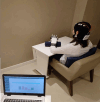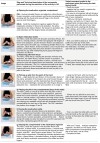The use of brain-machine interface, motor imagery, and action observation in the rehabilitation of individuals with Parkinson's disease: A protocol study for a randomized clinical trial
- PMID: 40193313
- PMCID: PMC11975075
- DOI: 10.1371/journal.pone.0315148
The use of brain-machine interface, motor imagery, and action observation in the rehabilitation of individuals with Parkinson's disease: A protocol study for a randomized clinical trial
Abstract
Background: Parkinson's disease (PD) is a neurodegenerative condition that impacts motor planning and control of the upper limbs (UL) and leads to cognitive impairments. Rehabilitation approaches, including motor imagery (MI) and action observation (AO), along with the use of brain-machine interfaces (BMI), are essential in the PD population to enhance neuroplasticity and mitigate symptoms.
Objective: To provide a description of a rehabilitation protocol for evaluating the effects of isolated and combined applications of MI and action observation (AO), along with BMI, on upper limb (UL) motor changes and cognitive function in PD.
Methods: This study provides a detailed protocol for a single-blinded, randomized clinical trial. After selection, participants will be randomly assigned to one of five experimental groups. Each participant will be assessed at three points: pre-intervention, post-intervention, and at a follow-up four weeks after the intervention ends. The intervention consists of 10 sessions, each lasting approximately 60 minutes.
Expected results: The primary outcome expected is an improvement in the Test d'Évaluation des Membres Supérieurs de Personnes Âgées score, accompanied by a reduction in task execution time. Secondary outcomes include motor symptoms in the upper limbs, assessed via the Unified Parkinson's Disease Rating Scale - Part III and the 9-Hole Peg Test; cognitive function, assessed with the PD Cognitive Rating Scale; and occupational performance, assessed with the Canadian Occupational Performance Measure.
Discussion: This study protocol is notable for its intensive daily sessions. Both MI and AO are low-cost, enabling personalized interventions that physiotherapists and occupational therapists can readily replicate in practice. While BMI use does require professionals to acquire an exoskeleton, the protocol ensures the distinctiveness of the interventions and, to our knowledge, is the first to involve individuals with PD.
Trial registration: ClinicalTrials.gov NCT05696925.
Copyright: © 2025 Estivalet et al. This is an open access article distributed under the terms of the Creative Commons Attribution License, which permits unrestricted use, distribution, and reproduction in any medium, provided the original author and source are credited.
Conflict of interest statement
The authors have declared that no competing interests exist.
Figures







Similar articles
-
Progressive muscle-strength protocol for the functionality of upper limbs and quality of life in individuals with Parkinson's disease: Pilot study.Complement Ther Med. 2020 Aug;52:102432. doi: 10.1016/j.ctim.2020.102432. Epub 2020 May 23. Complement Ther Med. 2020. PMID: 32951706
-
The Promotoer, a brain-computer interface-assisted intervention to promote upper limb functional motor recovery after stroke: a study protocol for a randomized controlled trial to test early and long-term efficacy and to identify determinants of response.BMC Neurol. 2020 Jun 27;20(1):254. doi: 10.1186/s12883-020-01826-w. BMC Neurol. 2020. PMID: 32593293 Free PMC article.
-
Short-term effects of Pilates-based exercise on upper limb strength and function in people with Parkinson's disease.J Bodyw Mov Ther. 2024 Jul;39:237-242. doi: 10.1016/j.jbmt.2024.02.032. Epub 2024 Feb 28. J Bodyw Mov Ther. 2024. PMID: 38876632
-
Action Observation and Motor Imagery as a Treatment in Patients with Parkinson's Disease.J Parkinsons Dis. 2024;14(s1):S53-S64. doi: 10.3233/JPD-230219. J Parkinsons Dis. 2024. PMID: 38250785 Free PMC article. Review.
-
Folic acid supplementation and malaria susceptibility and severity among people taking antifolate antimalarial drugs in endemic areas.Cochrane Database Syst Rev. 2022 Feb 1;2(2022):CD014217. doi: 10.1002/14651858.CD014217. Cochrane Database Syst Rev. 2022. PMID: 36321557 Free PMC article.
References
-
- Nielsen C, Siersma V, Ghaziani E, Beyer N, Magnusson SP, Couppé C. Health-related quality of life and physical function in individuals with Parkinson’s disease after a multidisciplinary rehabilitation regimen-a prospective cohort feasibility study. Int J Environ Res Public Health. 2020;17(20):7668. doi: 10.3390/ijerph17207668 - DOI - PMC - PubMed
Publication types
MeSH terms
Associated data
LinkOut - more resources
Full Text Sources
Medical

